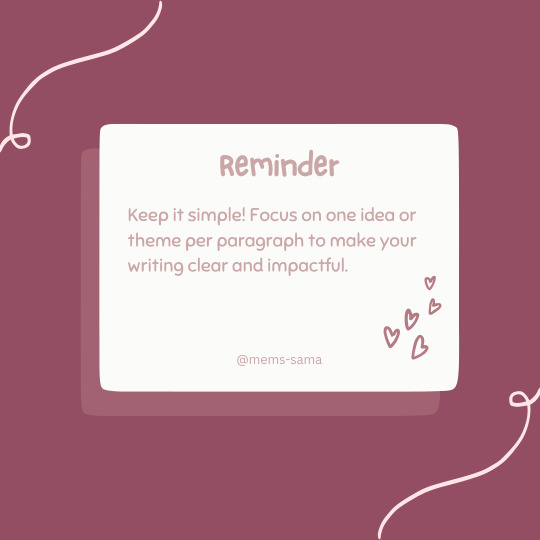Text
Anonymous asked: I just read saw your suggestion to serialize a large story instead of chopping it into smaller books. This idea sounds great! Is there any site/method you recommend? Or somewhere to find more info on the topic? I have been thinking of Wattpad, but I feel like original stories and those that aren't romance, go unnoticed against the fandom/romance content.
Kindle Vella and Radish are two popular platforms for publishing episodic stories or serials. Tapas, Yonder, and Inkitt are others. I'm not sure about which genres do best where, but they're all worth looking into.
As for Wattpad, although romance and fan-fiction do really well there, YA, fantasy, sci-fi, and supernatural are all said to do well there also. Mystery/thriller are said to be gaining traction there as well.
Here are some articles to Google with some great information:
-- How to Write Serialized Fiction for Kindle Vella by Jill Williamson (via Go Teen Writers)
-- How to Write a Serialized Story: 4 Reasons to Write Serial Fiction (via MasterClass)
-- The Joys (and Perils) of Serial Novel Writing by Will Willingham (via Jane Friedman)
-- Serial Writing, An FAQ by Alexander Wales
-- Plotting Addictive Serials Workshop + Free Serial Fiction Outlining Sheet (via Storytellers Rule the World on YouTube)
-- PLOT A STORY | Story Structure for Serials + FREE TEMPLATES (Scrivener) (via Author Brittany Wang on YouTube)
Happy writing!
•••••••••••••••••••••••••••••••••
I’ve been writing seriously for over 30 years and love to share what I’ve learned. Have a writing question? My inbox is always open!
LEARN MORE about WQA
SEE MY ask policies
VISIT MY Master List of Top Posts
COFFEE & FEEDBACK COMMISSIONS ko-fi.com/wqa
129 notes
·
View notes
Text

#writblr#writing#creative writing#writers on tumblr#on writing#writeblr#writing advice#writing adventures#writing community#writers#writerscommunity#writingblr#writing tips#writing help#how to write#writing stuff#writing resources#personal#memssama
9 notes
·
View notes
Text
Emotions in writing
The following examples have been taken from the book The Emotion Thesaurus: A Writer's Guide To Character Expression by Angela Ackerman & Becca Puglisi - make sure to get the book!
Confidence
Definition: having faith in one’s own influence and ability
Physical signals:
Strong posture (shoulders back, chest out, chin high)
Walking with wide steps
Strong hygiene and personal grooming
Holding the hands loosely behind the back
Touching one’s fingertips together (tapping, forming a steeple)
A gleam in one’s eye, an inner light
Smiling, a playful grin
Winking or giving someone an easy nod
Keeping one’s hands out of the pockets
Appearing relaxed (drumming fingers against a leg, humming)
Taking up space (legs spread wide, arms loose at the sides)
Approaching people with ease
Looking others directly in the eye
Arms swinging while walking
Choosing the middle, not the sides (be it a couch or a room)
Using exaggerated movements to draw attention to oneself
A booming laugh
Showing comfort in the close proximity of others
Initiating contact
Telling jokes, adding to or steering a conversation
Hosting events (getting the guys together for a football game)
Openness when dealing with people
Appearing unbothered by what others may think
Leaning in to talk or listen
Increased physical contact, becoming touchy-feely
Running hands through one’s hair or flipping the hair back
Assuming a pose that draws attention to one’s best attributes
Wearing clothes that are flashy or dramatic
Internal sensations:
Relaxed muscles
Easy breaths
Lightness in the chest
Cues of acute or long-term confidence:
Doing or saying things outside of the norm without anxiety or concern
Obsessively talking about an achievement or material object
Reacting with anger or jealousy if one’s reputation is impugned
Bragging, showing off
Cues of suppressed confidence:
Minimizing compliments
Modesty
Changing the topic to bring others into the spotlight
Downplaying one’s own comfort level to make others feel better
Asking for opinions or advice
#emotions in writing series#writing tips#writing advice#writing help#writing tools#writing resources#emotions in writing#writing life#writingblr#creative writing#on writing#writers of tumblr#writing community#writeblr#writing references#emotions and writing
476 notes
·
View notes
Text
Mems-sama's List of Writing Resources

This list will be added to over time. Kindly use it as your reference :>
About me
Emotions in writing series:
Anger
Amusement
Adoration
. . .
Writing the opening scene
Writing Reminders
Some tips on creating your own writeblr
Conquering the First Chapter
2 notes
·
View notes
Text
“Show, Don’t Tell”…But This Time Someone Explains It

If you’ve ever been on the hunt for writing advice, you've definitely seen the phrase “Show, Don’t Tell.”
Writeblr coughs up these three words on the daily; it’s often considered the “Golden Rule” of writing. However, many posts don't provide an in-depth explanation about what this "Golden Rule" means (This is most likely to save time, and under the assumption that viewers are already informed).
More dangerously, some posts fail to explain that “Show, Don’t Tell” occasionally doesn’t apply in certain contexts, toeing a dangerous line by issuing a blanket statement to every writing situation.
The thing to take away from this is: “Show, Don’t Tell” is an essential tool for more immersive writing, but don't feel like a bad writer if you can’t make it work in every scenario (or if you can’t get the hang of it!)
1. What Does "Show, Don't Tell" Even Mean?

“Show, Don’t Tell” is a writing technique in which the narrative or a character’s feelings are related through sensory details rather than exposition. Instead of telling the reader what is happening, the reader infers what is happening due to the clues they’ve been shown.
EXAMPLE 1:
Telling: The room was very cold.
Showing: She shivered as she stepped into the room, her breath steaming in the air.
EXAMPLE 2:
Telling: He was furious.
Showing: He grabbed the nearest book and hurled it against the wall, his teeth bared and his eyes blazing.
EXAMPLE 3 ("SHOW, DON'T TELL" DOESN'T HAVE TO MEAN "WRITE A LOT MORE")
Telling: The room hadn't been lived in for a very long time.
Showing: She shoved the door open with a spray of dust.
Although the “showing” sentences don’t explicitly state how the characters felt, you as the reader use context clues to form an interpretation; it provides information in an indirect way, rather than a direct one.
Because of this, “Show, Don’t Tell” is an incredibly immersive way to write; readers formulate conclusions alongside the characters, as if they were experiencing the story for themselves instead of spectating.
As you have probably guessed, “showing” can require a lot more words (as well as patience and effort). It’s a skill that has to be practiced and improved, so don’t feel discouraged if you have trouble getting it on the first try!
2. How Do I Use “Show, Don’t Tell” ?

There are no foolproof parameters about where you “show” and not “tell" or vice versa; it’s more of a writing habit that you develop rather than something that you selectively decide to employ.
In actuality, most stories are a blend of both showing and telling, and more experienced writers instinctively switch between one and another to cater to their narrative needs. You need to find a good balance of both in order to create a narrative that is both immersive and engaging.
i. Help When Your Writing Feels Bare-Bones/Soulless/Boring
Your writing is just not what you’ve pictured in your head, no matter how much you do it over. Conversations are stilted. The characters are flat. The sentences don’t flow as well as they do in the books you've read. What’s missing?
It’s possibly because you’ve been “telling” your audience everything and not “showing”! If a reader's mind is not exercised (i.e. they're being "spoon-fed" all of the details), your writing may feel boring or uninspired!
Instead of saying that a room was old and dingy, maybe describe the peeling wallpaper. The cobwebs in the corners. The smell of dust and old mothballs. Write down what you see in your mind's eye, and allow your audience to formulate their own interpretations from that. (Scroll for a more in-depth explanation on HOW to develop this skill!)
ii. Add More Depth and Emotion to Your Scenes
Because "Show, Don't Tell" is a more immersive way of writing, a reader is going to feel the narrative beats of your story a lot more deeply when this rule is utilized.
Describing how a character has fallen to their knees sobbing and tearing our their hair is going to strike a reader's heart more than saying: "They were devastated."
Describing blood trickling through a character's fingers and staining their clothes will seem more dire than saying: "They were gravely wounded."
iii. Understand that Sometimes Telling Can Fit Your Story Better
Telling can be a great way to show your characters' personalities, especially when it comes to first-person or narrator-driven stories. Below, I've listed a few examples; however, this list isn't exclusive or comprehensive!
Initial Impressions and Character Opinions
If a character describes someone's outfit as "gaudy" or a room as "absolutely disgusting," it can pack more of a punch about their initial impression, rather than describing the way that they react (and can save you some words!).
In addition, it can provide some interesting juxtaposition (i.e. when a character describes a dog as "hideous" despite telling their friend it looks cute).
2. Tone and Reader Opinions
Piggybacking off of the first point, you can "tell, not show" when you want to be certain about how a reader is supposed to feel about something. "Showing" revolves around readers drawing their own conclusions, so if you want to make sure that every reader draws the same conclusion, "telling" can be more useful!
For example, if you describe a character's outfit as being a turquoise jacket with zebra-patterned pants, some readers may be like "Ok yeah a 2010 Justice-core girlie is slaying!" But if you want the outfit to come across as badly arranged, using a "telling" word like "ridiculous" or "gaudy" can help set the stage.
3. Pacing
"Show, don't tell" can often take more words; after all, describing a character's reaction is more complicated than stating how they're feeling. If your story calls for readers to be focused more on the action than the details, such as a fight or chase scene, sometimes "telling" can serve you better than "showing."
A lot of writers have dedicated themselves to the rule "tell action, show emotion," but don't feel like you have to restrict yourself to one or the other.
iv. ABOVE ALL ELSE: Getting Words on the Page is More Important!
If you’re stuck on a section of your story and just can’t find it in yourself to write poetic, flowing prose, getting words on the paper is more important than writing something that’s “good.” If you want to be able to come back and fix it later, put your writing in brackets that you can Ctrl + F later.
Keeping your momentum is the hardest part of writing. Don't sacrifice your inspiration in favor of following rules!
3. How Can I Get Better at “Show, Don’t Tell”?

i. Use the Five Senses, and Immerse Yourself!
Imagine you’re the protagonist, standing in the scene that you have just created. Think of the setting. What are things about the space that you’d notice, if you were the one in your character’s shoes?
Smell? Hear? See? Touch? Taste?
Sight and sound are the senses that writers most often use, but don’t discount the importance of smell and taste! Smell is the most evocative sense, triggering memories and emotions the moment someone walks into the room and has registered what is going on inside—don’t take it for granted. And even if your character isn’t eating, there are some things that can be “tasted” in the air.
EXAMPLE:
TELLING: She walked into the room and felt disgusted. It smelled, and it was dirty and slightly creepy. She wished she could leave.
SHOWING: She shuffled into the room, wrinkling her nose as she stepped over a suspicious stain on the carpet. The blankets on the bed were moth-bitten and yellowed, and the flowery wallpaper had peeled in places to reveal a layer of blood-red paint beneath…like torn cuticles. The stench of cigarettes and mildew permeated the air.
“How long are we staying here again?” she asked, flinching as the door squealed shut.
The “showing” excerpt gives more of an idea about how the room looks, and how the protagonist perceives it. However, something briefer may be more suited for writers who are not looking to break the momentum in their story. (I.e. if the character was CHASED into this room and doesn’t have time to take in the details.)
ii. Study Movies and TV Shows: Think like a Storyteller, Not Just a Writer
Movies and TV shows quite literally HAVE TO "show, and not tell." This is because there is often no inner monologue or narrator telling the viewers what's happening. As a filmmaker, you need to use your limited time wisely, and make sure that the audience is engaged.
Think about how boring it would be if a movie consisted solely of a character monologuing about what they think and feel, rather than having the actor ACT what they feel.
(Tangent, but there’s also been controversy that this exposition/“telling” mindset in current screenwriting marks a downfall of media literacy. Examples include the new Percy Jackson and Avatar: The Last Airbender remakes that have been criticized for info-dumping dialogue instead of “showing.”)
If you find it easy to envision things in your head, imagine how your scene would look in a movie. What is the lighting like? What are the subtle expressions flitting across the actors' faces, letting you know just how they're feeling? Is there any droning background noise that sets the tone-- like traffic outside, rain, or an air conditioner?
How do the actors convey things that can't be experienced through a screen, like smell and taste?
Write exactly what you see in your mind's eye, instead of explaining it with a degree of separation to your readers.
iii. Listen to Music
I find that because music evokes emotion, it helps you write with more passion—feelings instead of facts! It’s also slightly distracting, so if you’re writing while caught up in the music, it might free you from the rigid boundaries you’ve put in place for yourself.
Here’s a link to my master list of instrumental writing playlists!
iv. Practice, Practice, Practice! And Take Inspiration from Others!
“Show Don’t Tell” is the core of an immersive scene, and requires tons of writing skills cultivated through repeated exposure. Like I said before, more experienced writers instinctively switch between showing and telling as they write— but it’s a muscle that needs to be constantly exercised!
If I haven’t written in a while and need to get back into the flow of things, I take a look at a writing prompt, and try cultivating a scene that is as immersive as possible! Working on your “Show, Don’t Tell” skills by practicing writing short, fun one-shots can be much less restrictive than a lengthier work.
In addition, get some inspiration and study from reading the works of others, whether it be a fanfiction or published novel!
If you need some extra help, feel free to check out my Master List of Writing Tips and Advice, which features links to all of my best posts, each of them categorized !
Hope this helped, and happy writing!
2K notes
·
View notes
Text
Conquering the First Chapter: A Guide for Writers
Have you ever wasted hours staring at a blank page, waiting for inspiration?
You struggle to come up with an idea for your story, but finally, inspiration strikes. You write the first chapter, believing it will make you a best-selling author. However, upon re-reading, you realize it needs improvement.
And then you toss all of it away.

Hey, I get it. Wrestling with that first chapter can feel like trying to solve a Rubik's cube blindfolded—it's a real head-scratcher! You want to hook your readers right from the start, but sometimes it feels like your words are doing the cha-cha in the wrong direction.
And let's be real, staring at that chapter for too long can make you want to throw your laptop out the window and start a career in llama farming instead. But let's stop for a moment. Take a deep breath and exhale.
Know that you're not the only one who's felt this way.
Loads of writers have gone through the "my first chapter is a dumpster fire" phase.
The good news? You can turn that dumpster fire into a sparkling beacon of literary goodness. Here are some practical things you can do in the meantime.
Step one: Give yourself a break. Seriously, put that chapter in timeout and come back to it later with a fresh perspective.
Step two: Get some outside opinions. Share your chapter with fellow writers or beta readers who can offer constructive feedback. And if all else fails, dive into the first chapters of books you love for a little inspiration pick-me-up.
Step three: Shake things up. If your first chapter is feeling stale, try approaching it from a different angle. Maybe start in the middle of a scene, or introduce a surprising twist early on. Don't be afraid to take risks and experiment with different narrative techniques to see what works best for your story.
Step four: Embrace the mess. Writing is a messy process, and it's okay to have a messy first draft. Don't get too hung up on making everything perfect right away. Sometimes, you need to embrace the chaos and let your creativity flow freely. You can always refine and polish your work later.

It's totally normal to have moments where you want to launch your laptop into the stratosphere. But remember, Rome wasn't built in a day, and neither is a perfect first chapter.
Keep at it, keep tweaking, keep pushing, and you'll get there. You've got this!

Next time, we'll discuss how to make the first chapter of your book more captivating for your readers. Make sure to catch it. Thank you for reading and have a great day!
#about writing#writing advice#writing#creative writing#on writing#writing stuff#writing tips#writing help#wrtieblr#creative wrting#wrtiting#writeblr#writingblr#writers on tumblr#writers#advice to self#note to self#how to write#writing resources
153 notes
·
View notes
Text
i think it's pretty cool you've figured out what works for you! :D and i haven't considered the word target instead of time target before. super interesting tbh 🤔 thanks for adding it!

16 notes
·
View notes
Note
Lots of people have told me I should self publish, but I think I still want to try to go through traditionally publishing my book first. I've got a finished manuscript, so how do I go about querying agents to find the best fit?
Pitching your manuscript to literary agents is a length process that requires lots of dedication, and a great deal of research. To get the most out of your querying, you definitely need to go in prepared.
We've put together this walk through for how to pitch your novel to literary agents, including some helpful do's and don'ts at the link below!
48 notes
·
View notes
Text

#writing reminders#writblr#writing#creative writing#writers on tumblr#on writing#writeblr#writing advice#writing adventures#writing community#writers#writerscommunity#writingblr#writing tips#writing help#how to write#writing stuff#writing resources
16 notes
·
View notes
Note
I want to create a writblr blog but idk what to consider. Are there dos and donts on making one?
hi there and thank you for asking.

Since I haven't been running this personal turned writblr blog for too long I'm not too familiar with the dos or don'ts of starting one but I shall share some points that I think would hopefully help you.
Dos:
Be genuine: Share your writing journey, (if you feel like it) by including both your struggles and successes and also by being honest and authentic. This helps you develop a true connection with your readers.
Interact with others: This one is one I'm guilty of not doing often enough but if you can make sure to Engage with fellow writblrs by liking, reblogging, and commenting on their posts. Building a community can be incredibly rewarding and can provide you with valuable feedback and insights.
Post regularly: This is also another one I struggle with but is super important. Because Consistency is key to growth. Whether it's sharing your own writing, reblogging prompts, or participating in writing challenges, staying active keeps your blog fresh and engaging.
Use relevant tags: Tag your posts with relevant keywords the ones I often use are: #wriblr, #poetry, #creativewriting, etc. These tags help others discover your content and eventually reach a wider audience.
Share your work: Don't be afraid to share your writing, even if you're unsure about it. Once you make some friends, writblrs are generally supportive and offer constructive feedback that can help you improve your writing skills.
Don'ts:
Avoid plagiarism: Always acknowledge the original source of ideas or work that you're sharing. And make sure to attribute them correctly since that's just the right thing to do since it isn't yours.
Stay away from drama: Although Tumblr can be a fun and lively platform, it's better to avoid unnecessary arguments or drama. Because it isn't good for your mental health. Instead, keep your focus on writing and maintaining a positive atmosphere.
Don't spam: While it's important to post regularly, try not to overpost or spam your followers' feeds. Quality content is more important than quantity.
Don't get discouraged by a lack of engagement: Gaining a following takes time. Just keep posting, interacting, and engaging with others, and your audience will eventually grow.
Pay attention to your blog's appearance: I think this one is important because a well-designed blog can attract more readers. Customize your theme and layout to make your blog visually appealing and easy to navigate.

If you follow these dos and don'ts you'll be able to create a fantastic writblr for yourself that reflects your writing passion and allows you to become a part of this wonderful community.✨
0 notes
Text
I am a terrible combination of “whatever happens, happens” and “If everything doesn’t go according to plan, I will vaporize”
46K notes
·
View notes
Text
I’m almost never serious, and I’m always too serious. Too deep, too shallow. Too sensitive, too cold hearted. I’m like a collection of paradoxes.
Ferdinand de Saussure
157 notes
·
View notes
Text
Dear starlight. I throw people away. Throw them right out of my life. Burn the bridge without looking back. It's easy when it's superficial people that I'm somewhat friends with and I don't think about later. But the problem is dire when it's people I let in and grown close to. Those people end up haunting my brain. And I hate that. So much.
excerpts from a book I will write one day
#spilled thoughts#spilled ink#poetry#writeblr#spilled poetry#poets on tumblr#spilled words#writers on tumblr#dear starlight#poetblr#writers and poets#poem
6 notes
·
View notes
Text
Dear starlight. Feelings are hard. Especially when you have been repressing them for so long. Learning to express them is challenging, scary and sometimes so very inconvenient. How do people do this? And why are they better at it than I am?
excerpts from a book I will write one day
#writing#spilled thoughts#writers on tumblr#poetry#writeblr#spilled poetry#poets on tumblr#spilled words#poetblr#writers and poets#poems#spilled ink#dear starlight
7 notes
·
View notes
Text
Turn on "prevent third-party sharing" in your settings!
Go into your settings, click on your blog name, scroll down and enable "prevent third-party sharing". I'm gonna be honest, I question how much/if this even prevents any AI bullshit, but do it just in case anyway.

Edit: On Mobile it's the Settings Gear, Visibility, Prevent third-party sharing.
You have to turn that on for all your blogs separately.
3K notes
·
View notes
Text
me: I’m a homebody i like to stay at home!
the home:
muddles my perception of time
Changes in both size and distance
lulls me into sense of safety and twist it into an oppressive paranoia inducing hellouse-scape
compels me to forget my own autonomous existence
waters down the outside and/ or exaggerate it to mythical extent
shrinks front door perron when i ascend, jarringly draws it out when i descend.
all its windows views are other walls of itself
the backyard fence looms in every horizon
bitter to abandonment of what belongs under its roof, including me when i go out to buy some good ol orange fanta
doesn’t look for me under its roof, it always knows where I’m.
when it sleeps doors never open, i don’t know it’s sleeping schedule
whatever happens silently around the corners is real, my apprehension is valid and understandable, and indeed i should panic.
8K notes
·
View notes